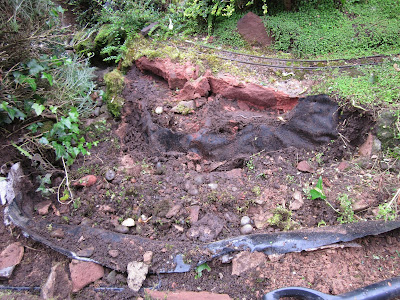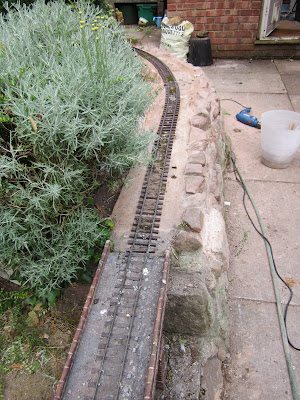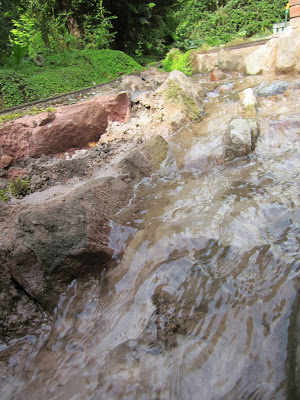 In the past month there have been a few developments on the railway and I have undertaken several
In the past month there have been a few developments on the railway and I have undertaken several maintenance jobs.
In terms of landscaping and the permanent way, I needed to repair and remodel the stream where it runs between the mill siding and the main line and some ballasting has been done at Bickerton Station. Rolling stock has increased by one - an open wagon with drop sides, On the lineside front, I have been constructing a Refreshment Room for the forecourt of Beeston Market Station and some PLR monogrammed benches for platforms. Operationally, because the track by the stream has been out of action for a while during, it has not been possible to run a full operating session - however, I did take the opportunity to test-run an LGB Otto battery conversion for a customer and have run various trains on an informal basis for test running.
Landscaping and Permanent Way
Revamping the stream
Because the stream had been losing water, I wrongly assumed that burrowing by mice beneath the trackbed beside the stream had been responsible. Removing the trackbed and the concrete and rock foundations to the stream to expose the plastic liner of the stream revealed it to be in good condition.It then tracked the 'leakage' to the sump cover (an inverted plastic dustbin lid), which had become clogged with dead leaves and soil.
As I had wanted to remodel this part of the stream to include a mill race, my efforts were not in vain. The stream has now been widened, the site for the water mill has been incorporated and the track relaid.
My next task is to construct the mill building and sluice gates controlling water flow to the wheel.
Although this was only done a couple of weeks ago, the wet weather has already encouraged the moss to start growing through.
The pointwork and station area now need to be weathered as has been done at Beeston Market Station (see How I ballasted Beeston Market station - Stage 3).
Rolling Stock
After realising that the coaling stage I had made for Beeston Market was too wide for some locos (see How I made a coaling stage), I decided that an open wagon and a plank would act as a suitable alternative.However, the way I have constructed my open wagons from my own resin castings (see How I made wagons from my own resin castings) means that it is not easy to drop the sides of the wagons without a rebuild. I then happened to see a drop-sided open wagon for sale on eBay for a reasonable price and it has now joined the stock roster.
Once it has been weathered and loaded with coal, it will form part of regular goods services - though will probably spend most of its life shuttling between the coal yard and the engine shed at Beeston Market.
Lineside
Refreshment Room
As you will have noticed from Progress Report 68, I am beginning to improve the detailing at Beeston Market Station by adding railway related buildings and structures such as the water tower and water crane. I have now also made a start on detailing the forecourt for the station. Eventually, this will be cobbled, have pavements (sidewalks), fencing and maybe even a couple of street lamps. Beside the station at the real Beeston Market and Tarporley mainline railway station, there used to be a couple of refreshment rooms. These appear to have been timber buildings which also offered additional services - groceries in one case and antiques in the other.At present, the building has no roof or interior, but hopefully this will be remedied before the next progress report.
PLR Station seats
After seeing a posting on one the Facebook Groups which I subscribe to (https://www.facebook.com/groups/814561258654535/), I contacted the postee and ordered some bespoke platform seats from him, after sending an image of a Peckforton Light Railway monogram which I had mocked-up in a Draw package.The laser-cut pieces have duly arrived and I am in the process of making up the dozen seats. These will eventually be deployed around the railway.
Operations
Operations have been somewhat restricted since the previous post because of the major engineering works beside the stream. However, some informal operating sessions have taken place. One was to give a thorough test-run to an LGB Otto loco which had been converted to battery power and radio control for a fellow modeller.The model was in the process of modification from its ToyTrain origins to a half-cab loco more appropriate for a UK based railway - it was still awaiting a chimney and a driver at this point.
After the stream had been remodelled (see above), I felt it needed to be thoroughly tested and so a few trains were run and filmed as they passed by the stream. Normally, I do not film from the side of the stream where the mill will be located as the background would be the brick walls of the house and the leanto. I decided to experiment with 'green screen' editing in my video editing program (VideoStudio) and so erected some blue plastic which had been used to wrap a mattress recently delivered.
Although not perfect; the breeze sometimes caught the plastic and flapped it around; I am pleased with the potential this offers for substituting more suitable backgrounds for some of the shots on my railway. The green-screened shots are the first two on this video.
By the way, any colour can be selected by my editing package for the matte screening - I opted for blue because hardly anything on my railway is blue - I could just as easily have chosen orange or yellow.















































